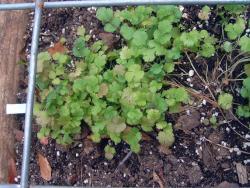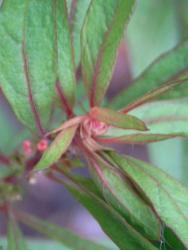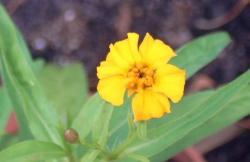A few of the less common herbs that are vital to the festive Mexican flavor are Cilantro (Coriandrum sativum), Epazote (Chenopodium ambrosiodes), and Aniz (Tagetes lucida), which is also known as Mexican mint marigold or Texas tarragon.
This assortment of herbs is worth a second glance and is quite easy to start from seed. These herbs are annuals and will reseed freely, providing seed to replant and to share with others.
~~~~~~~~~~~~~~~~~~~~~~~~~~~~~~~~~~~~~~~~
Cilantro (Coriandrum sativum): Fresh coriander leaves look like parsley, but with a unique spicy flavor. Cilantro leaves add zest to salsas, salads, and beans. If used fresh in cooked dishes, Cilantro is best added near the end of the cooking time.
The coriander seeds will develop a nutty flavor when ripened. They can be ground and added as a seasoning to bean dishes. Crushed or whole seed can be used to flavor salads, soups, meats, and desserts.
Cilantro will grow well in the garden environment. This herb is an annual that grows from twelve to eighteen inches in height. It prefers full sun, and it also will grow well under cooler growing conditions.

Cilantro currently growing in a raised bed in January in zone 8a.
In the south, it is a cold-weather herb that can be harvested throughout the winter season. It will bloom and seed in springtime when weather warms. The seeds fall as soon as ripened. I find it best to cut the seed stalks and place them in a paper bag to catch the seeds.
~~~~~~~~~~~~~~~~~~~~~~~~~~~
Epazote (Chenopodium ambrosiodes): This herb is frequently used in Mexico, but is rarely mentioned in recipes. It is frequently used in bean dishes, corn, and fish. It is reputed to aid in digestion and prevent flatulence.
Epazote is an annual that is easy to start from seed, and once it is growing, it can reseed with abandon. Freezes will control it, but the seeds will germinate freely in spring time.

This herb has a rank smell, which is quite difficult to describe. Dried branches of it can be used to repel weevils in dried foods. A tisane or herbal tea was commonly used in Mexican folk medicine as a vermifuge to expel intestinal worms.
The flowers are miniscule at the end of two to three foot tall stems. They will bloom throughout the summer. The teeny tiny blooms will quickly develop seeds and will reseed indiscriminately.

Many consider it a weed, comparable to the other chenopodiums. One of the more commonly known is Goosefoot. It is said that once you plant Epazote, you will never be without it.
It is easy to start from seed by placing the seeds on the surface of the soil and keeping them moist until germination. It prefers full sun, but like most herbs, it doesn't need rich soil.
~~~~~~~~~~~~~~~~~~~~~~
Mexican Mint Marigold (Tagetes lucida): This is commonly called Aniz or Texas Tarragon. It lends an anise or licorice flavor to chicken or fish. Like other fresh herbs, it is best when added at the end of cooking. The delicate flavor is lost if added too early. The dried leaves also make a wonderful tea to complement a meal or a dessert. The leaves can also be used in potpourri blends.
These plants have lush green foliage and grow from two to three feet tall. Although they bloom all summer, in the fall they are loaded with golden marigold-like blooms. The blooms will develop an ample amount of seed. As in the case of the other herbs, there will be plenty to replant and to share with others.

A marigold-like bloom of the Mexican Mint Marigold.
The seeds germinate easily when planted in full sun. In temperate climates, this herb will return from the roots as a tender perennial. For medicinal purposes, this plant will act as a stimulant and diuretic, and also will improve digestion. Its value as a tea is also touted for calming nerves and settling stomachs.
French tarragon doesn't like hot, humid climates, so I find this a suitable substitute. It also makes an attractive plant in an ornamental setting.
~~~~~~~~~~~~~~~~~~~
These three herbs will be a good addition to your herbal garden and will enhance your culinary skills in the kitchen as well. I suspect there are more and I would love to hear about the ones you like to grow and use in the kitchen.
| Thread Title | Last Reply | Replies |
|---|---|---|
| Your epazote by wildflowers | Apr 23, 2015 10:04 PM | 4 |
| Informative! by Wes | Apr 22, 2015 3:49 PM | 3 |